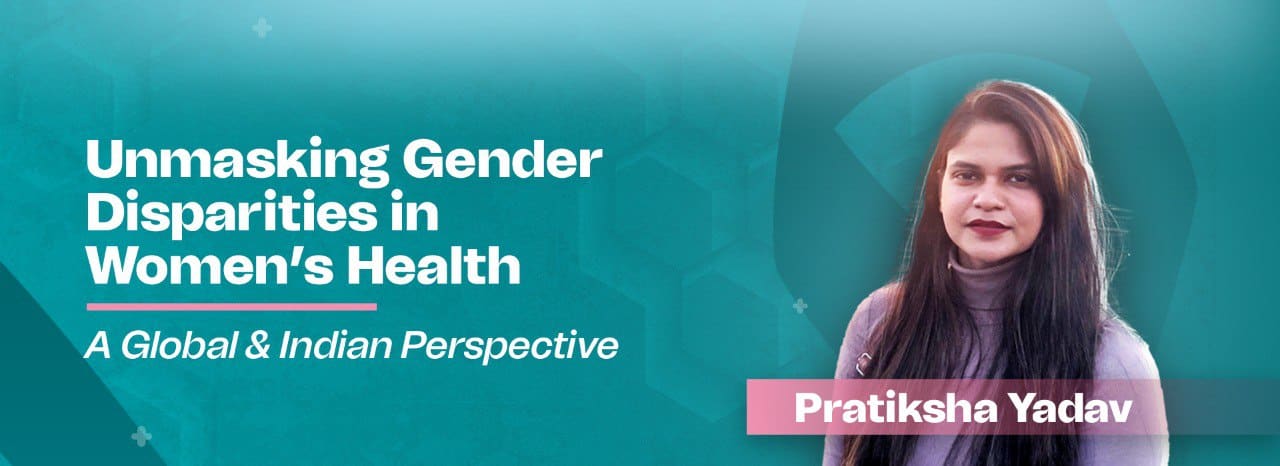
05 Jan Unmasking Gender Disparities in Women’s Health: A Global and Indian Perspective
Introduction
Gender disparities are woven deeply into the fabric of healthcare systems worldwide, particularly affecting women. These inequities have far-reaching implications for the overall well-being of women, impacting their access to essential resources, physical and mental health, and their roles in caregiving and reproductive health. While the challenges faced by women in healthcare are universal, this article will delve into the specific gender inequities in women’s health in India, a country grappling with high maternal mortality rates and a multitude of health disparities based on gender. India, the second-most populous nation on Earth, is no exception, as it grapples with deeply entrenched gender-based disparities in women’s health. These inequities manifest in various forms, from restricted access to healthcare services to deeply ingrained cultural norms that hinder women’s autonomy and decision-making power in matters of health.
Women are different than men
The Unique Needs of Women
Women’s physiology differs from that of men. Beyond the obvious reproductive distinctions that impact women throughout their lives, such as fertility, pregnancy, menopause, and various gynaecological disorders, women also contend with conditions like breast, ovarian, and cervical cancers. However, even for “gender-neutral” diseases like sleep apnea or heart attacks, women may go undiagnosed because their symptoms differ from those typically seen in men. This means there is no one-size-fits-all diagnosis and treatment for both genders.
The Question Remains: Why Does Women’s Healthcare Research Lag Behind?
Challenges in Women’s Healthcare
1. Male-Directed Clinical Research:
Historically, medical research has been predominantly male-oriented. For instance, the Physician’s Health Study, which examined the effects of aspirin on cardiovascular disease, involved 22,000 male patients, with not a single female participant(From reference 1: Forbes report*). Furthermore, women of childbearing age were prohibited from enrolling in phase I clinical trials during the 1970s. Consequently, treatments have been developed without knowledge of their effectiveness and safety in women.
2. Poverty and Limited Access to Healthcare:
Women are more likely to live in poverty than men, which can restrict their access to healthcare and other essential resources, leading to adverse health outcomes. Violence and Discrimination: Women often experience violence and discrimination, with detrimental effects on their physical and mental health. These experiences are prevalent worldwide. But gender-based violence still remains a pervasive issue in India, with women more likely than men to experience domestic violence and sexual assault, further impacting their overall health.
3. Unpaid Care Work: Women are frequently responsible for unpaid care work, such as looking after family members, which limits their time and resources for their own health and well-being. Barriers to Sexual and Reproductive Health Services: Women and girls often encounter obstacles in accessing sexual and reproductive health services, including contraception and safe abortion, which are fundamental to their reproductive autonomy and overall health. Indian women are less likely than men to receive preventive care, such as cancer screenings and immunizations, leaving them more vulnerable to preventable health issues. In addition to this, Indian women are disproportionately affected by malnutrition and anaemia, which have serious consequences for their health and well-being.
4. The disparity in research funding is glaring.
A funding analysis by the U.S. National Institutes of Health (NIH) showed that research funding was disproportionately allocated to male-led studies at the expense of those that affect primarily women. As a result, there is less focus on the development of treatments and therapies tailored to the needs of women, leading to poorer outcomes for women. For instance, one study found that women were significantly less likely to receive an initial diagnosis of heart failure than men, even after adjusting for differences in age, race and other factors. The researchers attributed this disparity to the lack of attention paid to the needs of women in healthcare research and clinical practice. Similarly, studies have found that women are more likely to suffer from long-term health problems related to medical conditions such as diabetes than men. Yet these disparities have often gone unrecognized and untreated due to the lack of research focused on female patients.
Conclusion
Gender inequities in women’s health persist globally and are particularly pronounced in India. The challenges faced by women include high maternal mortality rates, limited access to preventive care, malnutrition, domestic violence, and barriers to sexual and reproductive health services. Cultural norms and gender roles play a significant role in Indian women’s health. Data from the National Family Health Survey in India reveals that only 12% of women aged 15-49 make decisions about their own healthcare, compared to 34% of men in the same age group. These figures underscore the impact of cultural norms on women’s decision-making power concerning their health. To address these inequities, it is imperative to work toward gender equality in healthcare, ensuring that women have equal access to essential resources, quality healthcare, and freedom from violence and discrimination. Achieving gender equity in healthcare is not only a matter of justice but is also essential for the overall health and well- being of societies worldwide.
About Author
Pratiksha Yadav is an intern with CAPED India and is currently pursuing MBA from SOIL Institute of Management.
References:
1. https://www.forbes.com/sites/forbesbusinessdevelopmentcouncil/2023/03/07/ignored-and-underrepresented-the- impact-of-excluding-women-in-healthcare-research/?sh=6b8432c6628a
2. Breaking the Taboo: Addressing Gender Inequities in Women’s Health in India- Mridu Gupta


